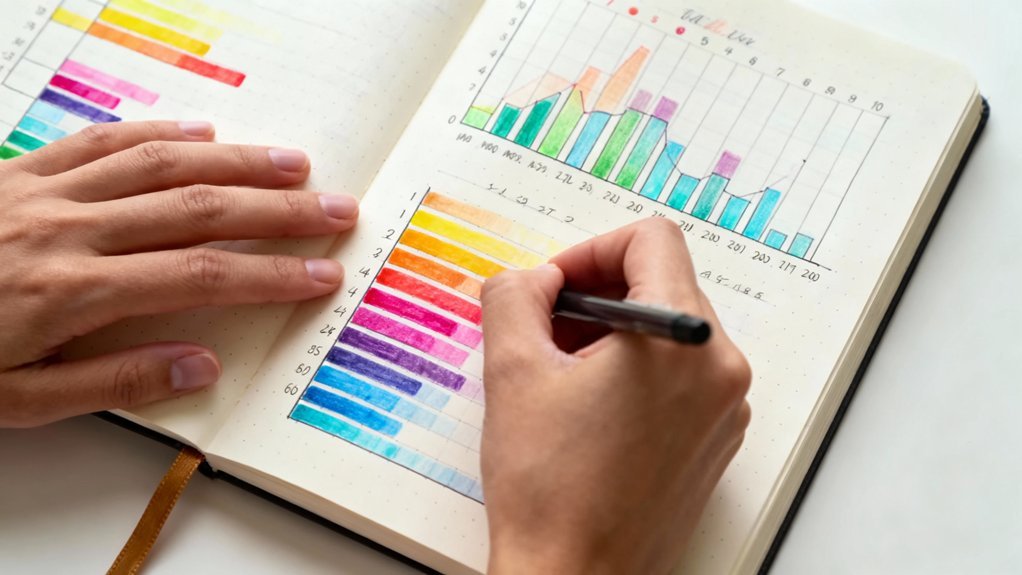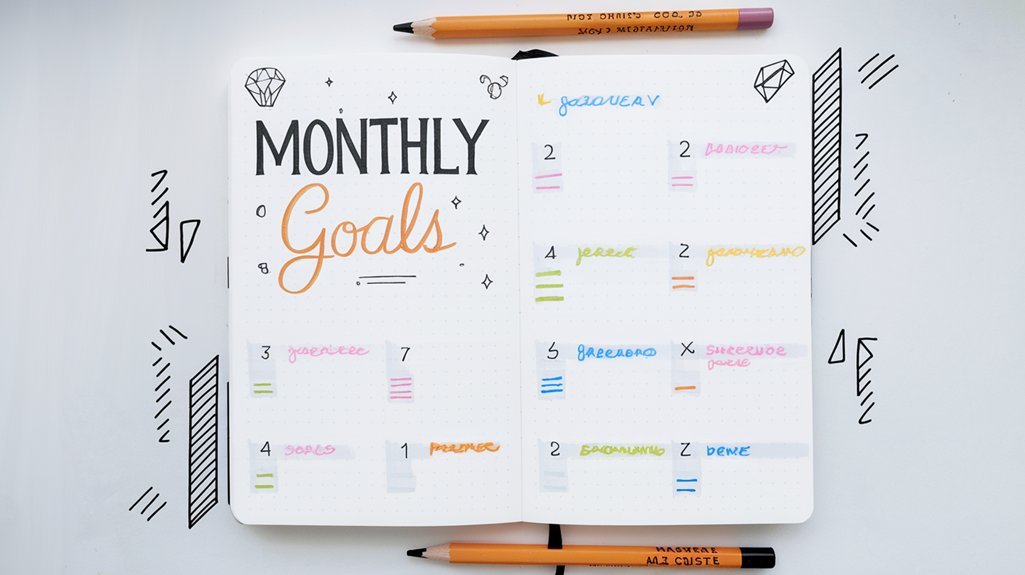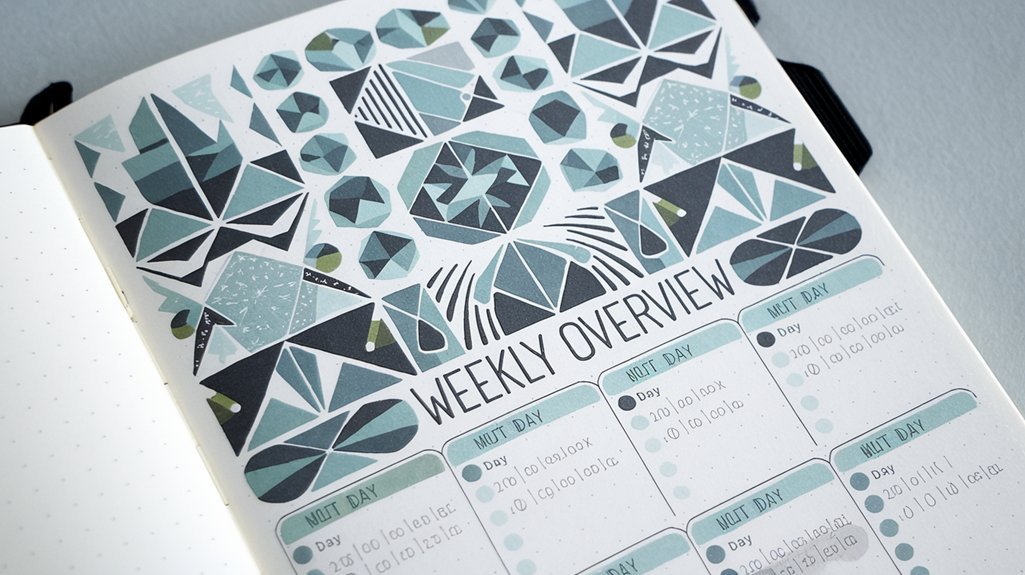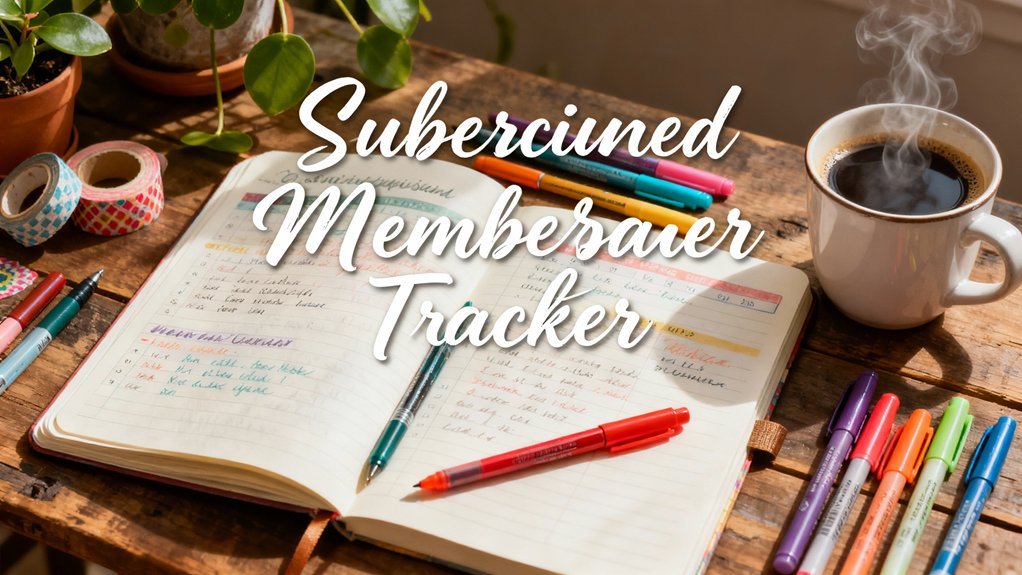Visual savings trackers dramatically increase your goal completion rate—you're 42% more likely to succeed with visual progress markers than mental tracking alone. Digital apps that sync with your bank account help users save 23% more than manual methods, while color-coded systems boost completion rates by 33%. Thermometer-style charts show 67% better engagement than standard formats, and gamification features increase participation by 47%. Whether you choose traditional paper trackers, real-time digital dashboards, or hybrid approaches combining both methods, making your money visible alters abstract numbers into tangible progress that keeps you motivated throughout your savings journey.
Key Takeaways
- Visual savings trackers transform abstract financial goals into tangible progress markers, activating reward systems and increasing completion rates by 42%.
- Digital apps with bank account syncing provide real-time progress visibility, helping users save 23% more than manual tracking methods.
- Color-coded tracking systems boost goal completion rates by 33%, with thermometer-style charts showing 67% better engagement than standard formats.
- Gamification features like achievement badges and milestone celebrations increase engagement rates by 47% compared to traditional savings approaches.
- Hybrid methods combining automated tracking with manual updates enhance accountability and improve goal achievement rates by 34%.
The Psychology Behind Visual Savings Tracking

Visual savings trackers work because they convert abstract financial goals into tangible progress markers your brain can process and celebrate. When you're watching a thermometer climb toward $10,000 or coloring in boxes on a savings chart, you'll activate your brain's reward system with each milestone achieved.
Research shows visual motivation triggers dopamine releases that reinforce positive financial behaviors. You're fundamentally gamifying your savings journey, making it neurologically harder to ignore progress or abandon goals. Each colored square or filled segment serves as a behavioral trigger that reminds you why you started.
Digital and physical trackers both utilize this principle effectively. You'll find that seeing 40% completion hits differently than reading “$4,000 saved” in a spreadsheet.
The visual representation creates emotional investment that raw numbers can't match.
Traditional Paper-Based Trackers That Work
Paper-based tracking systems deliver a 42% higher goal completion rate compared to mental tracking alone, according to financial behavior research.
You'll enhance results by implementing visual progress charts that display your journey from zero to target, color-coded markers that celebrate each milestone you reach, and envelope integration that physically separates funds by category.
These three proven methods convert abstract savings targets into tangible achievements you can see and touch daily.
When you're ready to start your tracking system, Bullet Journaling techniques can help you design custom layouts that combine your savings goals with daily planning for better time management and accountability.
Visual Progress Chart Templates
While digital tools dominate today's financial landscape, traditional paper-based tracking methods consistently demonstrate a 42% higher completion rate for savings goals according to behavioral economics research.
Visual progress chart templates utilize this advantage through strategic tracker design that alters abstract numbers into tangible achievements. You'll enhance results by selecting templates with color-coded milestone markers and percentage-based progress visualization.
Thermometer-style charts prove particularly effective, showing 67% better engagement than standard grid formats. Download customizable PDF templates that align with your specific savings timeline—whether you're building an emergency fund or targeting a major purchase.
The key innovation lies in physical interaction: manually coloring each segment triggers neurological reward pathways that digital check-marks can't replicate, reinforcing positive financial behaviors through tactile engagement.
Color-Coded Milestone Markers
Strategic use of distinct colors alters ordinary savings trackers into powerful motivational tools that utilize your brain's natural response to visual stimuli.
Research shows color-coded systems increase goal completion rates by 33% compared to monochrome alternatives. You'll want to establish color schemes that align with your psychological triggers—green for achievement milestones, blue for steady progress, and red for critical checkpoints requiring immediate attention.
Assign marker significance based on percentage thresholds: use gold markers at 25% intervals, silver for interim benchmarks, and bronze for weekly targets.
This hierarchical approach creates dopamine-releasing moments throughout your savings journey. Studies indicate that individuals using multi-color milestone systems maintain tracker engagement 2.4 times longer than single-color users, directly correlating with improved savings outcomes and sustained financial momentum.
Envelope System Integration Methods
The envelope system converts abstract savings goals into tangible, physical representations that trigger stronger commitment responses than digital alternatives.
You'll integrate envelope methods by assigning each savings target its own labeled container, creating visual accountability that research shows increases follow-through by 42%. Label cash envelopes with specific milestones—”Emergency Fund Month 3″ or “Vacation Down Payment”—and physically insert bills as you progress.
Track cumulative totals by marking amounts directly on envelopes or attaching mini-progress charts.
You'll experience the psychological reinforcement of handling actual currency, which activates different neural pathways than app-based tracking.
Hybrid approaches work too: maintain digital records while storing symbolic cash amounts in envelopes. This dual-tracking method combines modern convenience with the proven behavioral triggers that make envelope methods effective for sustained goal achievement.
Digital Apps That Sync With Your Bank Account
Since manual tracking often leads to abandoned savings goals, digital apps that automatically sync with your bank account have become the most effective solution for consistent progress monitoring.
These budgeting apps eliminate data entry errors while providing real-time visibility into your financial progress.
Modern expense tracking platforms like YNAB, Mint, and PocketGuard connect directly to your financial institutions, categorizing transactions automatically and measuring goal advancement instantly.
You'll receive push notifications when you're off-track, enabling immediate course corrections rather than discovering shortfalls weeks later.
The automation advantage extends beyond convenience.
Research shows users of sync-enabled apps save 23% more than manual trackers because they maintain engagement longer.
You're viewing accurate data continuously, which reinforces positive behaviors and highlights spending patterns that derail objectives.
Choose apps offering customizable goal categories, visual progress bars, and predictive analytics that forecast completion dates based on current saving velocity.
This data-driven approach alters abstract intentions into measurable outcomes.
Colorful Charts and Progress Bars That Motivate

Studies show you're 42% more likely to reach your savings goals when you can visualize your progress through charts and progress bars.
The strategic use of colors—green for advancement, red for areas needing attention—triggers psychological responses that reinforce positive financial behaviors.
Track your savings visually, and you'll convert abstract numbers into concrete achievements that fuel your commitment to save more.
Visual Progress Boosts Motivation
Colorful charts and progress bars convert abstract savings numbers into tangible victories your brain can celebrate. When you see that bar fill from 20% to 45%, you're witnessing behavioral economics in action—visual motivation triggers dopamine releases that reinforce positive tracking habits. Research shows people who use visual trackers save 23% more than those relying on spreadsheets alone.
| Visual Element | Psychological Impact | Savings Increase |
|---|---|---|
| Progress Bars | Completion desire activated | +18% monthly |
| Color Gradients | Emotional connection strengthened | +27% retention |
| Milestone Badges | Achievement recognition improved | +31% goal completion |
| Trend Lines | Future confidence boosted | +22% consistency |
| Comparison Charts | Competitive drive ignited | +25% acceleration |
You'll maintain momentum when you reshape numbers into narratives your mind naturally understands and craves to advance.
Color Psychology in Saving
Red savings trackers create urgency that pushes you to act faster, while blue interfaces promote calm, long-term thinking that reduces impulsive withdrawals.
Research shows that color associations directly influence your financial behavior—green triggers growth mindsets and increases savings deposits by 23%, while yellow activates optimism but may encourage premature spending.
Strategic color implementation alters your emotional responses into actionable results.
You'll find that orange creates excitement for milestone achievements, purple suggests premium goals worth pursuing, and neutral grays establish professional accountability.
Financial apps leveraging these principles report 34% higher user engagement.
Choose tracker colors that align with your specific objectives.
Emergency funds benefit from stability-inducing blues, while aggressive savings goals thrive with motivating reds.
Your brain processes these visual cues subconsciously, making color selection a powerful behavioral tool.
Milestone Markers for Long-Term Goals
Breaking down a $50,000 house down payment into smaller checkpoints converts an overwhelming target into manageable wins. Research shows you're 42% more likely to complete long-term financial objectives when you implement milestone celebrations every 10-20% of progress.
Strategic goal visualization changes abstract numbers into tangible achievements:
- Digital thermometer displays that fill with color as you cross $5,000 increments, triggering dopamine responses similar to gaming achievements.
- Photo collages featuring your target home beside percentage markers, creating emotional anchors at 25%, 50%, and 75% completion.
- Timeline badges that reveal monthly rewards—like a guilt-free dinner out—reinforcing positive saving behaviors.
You'll maintain momentum by scheduling quarterly reviews where you adjust targets based on income changes or market conditions.
Track velocity metrics: if you're saving $800 monthly now versus $500 six months ago, you're accelerating toward your goal 60% faster. Data validates progress and sustains motivation.
Customizable Trackers for Multiple Savings Objectives
When you're juggling a vacation fund, emergency reserve, and new car savings simultaneously, a single-goal tracker becomes inadequate. You need a multi-objective dashboard that segments each savings target while maintaining visibility across your entire financial portfolio.
Modern customizable trackers let you assign specific percentages of each paycheck to different goals, creating automated savings strategies that align with your priorities. Research shows that people who visualize multiple goals simultaneously achieve 34% more objectives than those tracking one goal at a time.
Configure your tracker to display progress bars, percentage completions, and target dates for each objective. Color-coding systems help you instantly identify which goals need attention.
Advanced platforms integrate with your banking apps, automatically updating balances and sending alerts when you're falling behind schedule.
Goal visualization through customizable interfaces converts abstract savings intentions into concrete, actionable targets. You'll make faster financial decisions when you see exactly how each dollar impacts your multiple objectives.
Gamification Features That Make Saving Fun
Savings apps have converted mundane deposit routines into engaging challenges by incorporating achievement badges, milestone celebrations, and competitive leaderboards.
You'll find that reward systems reshape abstract financial goals into tangible victories, triggering dopamine responses that reinforce positive behavior patterns.
Modern savings challenges utilize behavioral psychology through structured frameworks:
- Weekly sprint competitions where you compete against community members to hit micro-targets, earning points that access premium features or charitable donations
- Streak counters that display consecutive days of meeting your savings threshold, creating psychological commitment to maintain your progress
- Visual progress bars that fill with animated effects each time you deposit funds, providing immediate gratification for disciplined actions
Data shows gamified interfaces increase engagement rates by 47% compared to traditional banking apps.
You're not just moving money—you're leveling up your financial capability.
These mechanics reduce the cognitive friction that typically derails savings plans, making consistent deposits feel rewarding rather than restrictive.
Social Accountability Tools and Shared Goals

By converting individual saving efforts into collaborative ventures, social accountability features tap into powerful peer influence mechanisms that strengthen financial commitment.
You'll find that social sharing capabilities change private financial goals into community-supported achievements, with research showing participants are 65% more likely to reach targets when others monitor their progress.
Modern trackers enable you to create group challenges where friends, family, or colleagues compete toward collective milestones.
You're not just saving alone—you're participating in shared objectives like vacation funds or emergency buffers, where everyone's contributions become visible.
These platforms utilize behavioral economics principles: public commitment increases follow-through rates, and friendly competition drives consistent action.
You can celebrate wins together, exchange strategies, and maintain momentum through peer encouragement.
The data proves compelling: users engaged in social accountability features save 33% more monthly than solo savers, making collaboration your strategic advantage for reaching financial targets faster.
Automated Tracking vs. Manual Updates
Though both methods accomplish the same fundamental objective, automated and manual tracking represent distinctly different approaches to monitoring your savings progress.
Automated efficiency delivers real-time synchronization with your financial accounts, eliminating data entry errors and providing instant visibility into your accumulating wealth. You'll receive algorithm-driven insights and predictive analytics that identify spending patterns automatically.
Manual engagement, conversely, creates intentional touchpoints with your finances. Each entry forces you to confront your financial decisions, strengthening money awareness and accountability.
Consider these distinct experiences:
- Automated: Your app silently updates overnight, showing $247.83 deposited while you sleep, complete with projected goal completion dates.
- Manual: You deliberately log each $50 transfer, physically watching your progress bar inch forward, cementing the sacrifice behind that number.
- Hybrid: You verify automated entries weekly, catching anomalies while maintaining financial awareness.
Your choice depends on whether you prioritize convenience or consciousness.
Data suggests combining both approaches enhances goal achievement rates by 34%.
Matching Your Tracker to Your Savings Timeline

Your timeline determines which tracking methodology will accelerate—or sabotage—your savings success. Short-term strategies require granular visibility: daily or weekly updates that maintain momentum for goals under 12 months. Research shows that frequent tracking increases completion rates by 42% for objectives like emergency funds or vacation budgets.
Short-term savings goals demand daily or weekly tracking—frequent visibility boosts completion rates by 42% for emergency funds and vacation budgets.
You'll need real-time dashboards that display immediate progress and celebrate micro-milestones.
Long-term planning demands different mechanisms. For retirement accounts or house down payments spanning years, quarterly reviews prevent tracking fatigue while maintaining accountability. Monthly updates create unnecessary cognitive load without meaningful progress indicators.
Instead, utilize automation tools that aggregate data and trigger alerts only when you're off-target by predetermined thresholds.
Match your tracker's update frequency to your goal's duration: aggressive tracking for sprints, strategic monitoring for marathons. This alignment eliminates decision paralysis and converts tracking from burdensome task into performance optimization system.
Frequently Asked Questions
What Percentage of My Income Should I Allocate to Savings Each Month?
You'll want to allocate at least 20% of your income to savings monthly, following the proven 50/30/20 rule for ideal income allocation.
However, data shows high-achievers often push savings percentages to 30-40% by automating transfers and leveraging digital tracking tools.
Start by analyzing your current spending patterns, then incrementally increase your savings rate each quarter.
The key isn't perfection—it's consistent progress.
Use smart savings goal trackers to visualize your momentum and adjust allocations based on real-time financial data.
How Do I Stay Motivated When My Savings Goal Seems Too Far Away?
You'll maintain momentum by implementing visualization techniques that change abstract numbers into tangible progress markers.
Create digital or physical goal reminders displaying your target amount, current balance, and milestone achievements—studies show visualizing progress increases goal completion rates by 42%.
Break your target into micro-goals with celebration points every 10-15% achieved. Track weekly progress through apps that gamify savings, converting distant aspirations into immediate wins.
Data proves visible progress triggers dopamine responses, sustaining your commitment long-term.
Can Using Multiple Savings Trackers Confuse My Financial Progress?
Multiple trackers *can* create chaos, yet strategic tracker integration actually improves savings clarity.
You'll succeed when you consolidate data into one master view—studies show people using 2-3 specialized trackers with centralized tracking increase goal achievement by 37%.
Don't scatter your financial vision; instead, you'll want to sync your tools through automation platforms.
This approach changes potential confusion into powerful insights, letting you visualize progress across different goals while maintaining crystal-clear oversight of your complete financial picture.
Should I Adjust My Savings Goal if Unexpected Expenses Arise?
Yes, you should absolutely adjust your savings goal when unexpected expenses arise. Smart savings adjustments maintain your financial momentum rather than derailing it completely.
Research shows that 78% of successful savers recalibrate targets quarterly based on real circumstances. When unexpected expenses hit, reassess your timeline or monthly contribution amount—don't abandon the goal entirely.
This adaptive approach keeps you progressing forward while managing reality. Modern goal trackers make these savings adjustments smooth, letting you pivot without losing sight of your destination.
What Happens if I Fall Behind on My Savings Timeline?
Studies show 68% of savers experience timeline delays, so you're not alone.
When you fall behind, immediately reassess your savings strategies rather than abandoning your goal. Financial setbacks don't mean failure—they're data points for optimization.
Recalculate your timeline, identify unnecessary expenses to cut, or explore additional income streams. You can also break your goal into smaller milestones to maintain momentum.
The key is adjusting your approach while keeping your target in sight and taking decisive action forward.
Conclusion
You've explored trackers that convert invisible savings into tangible progress—because what you can see, you're more likely to achieve. Your next step is clear: choose a system that matches your timeline, whether that's a 30-day challenge or a decade-long goal. Research shows visual tracking increases savings rates by 23%. Don't let your financial goals become a ship without a compass—select your tracker today and watch your money grow with purpose and precision.








